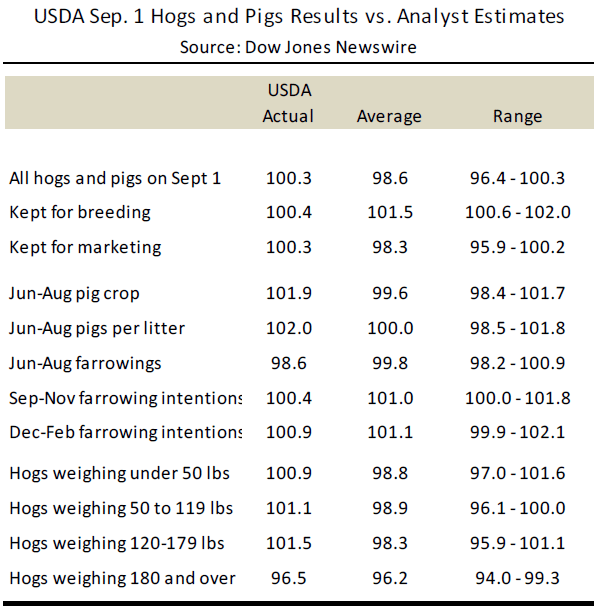



CME: USDA Survey Results Contradict Market Expectations
US - Analysts and market participants were left scratching their heads following the release of the latest USDA "Hogs and Pigs" survey results, write Steve Meyer and Len Steiner.Coming into the report, there was broad expectation that: a) the inventory numbers would be lower than a year ago; b) the breeding herd would show some form of expansion with lower feed costs expected in the next 12 months; c) the PEDv impacted the number of pigs saved per litter and reduced productivity during the Jun - Aug quarter; and d) the farrowings for the Dec—Feb quarter would show solid growth above 1 per cent, implying a little over 2.5 per cent growth in pigs coming to market in late spring and early summer of 2014. USDA survey results contradicted market expectations on all those counts (see table).

Below is a recap of the results and the implications for pork supplies going forward:
The USDA survey pegged the supply of market hogs as of September 1 at 62.546 million hogs, 0.3 per cent larger than a year ago. This was outside the range of pre-report estimates and emphatically contradicts the view that hog supplies on the ground are lower than a year ago. The inventory of hogs and pigs over 180 pounds was estimated at 11.090 million head, 3.5 per cent lower than a year ago. If this number is correct, then we should see a significant increase in hog slaughter in the next two weeks.
Hog slaughter in the first four weeks of September (1 September - 28 September) was 8.524 million head down about 7.7 per cent compared to the same four weeks last year. Weekly hog slaughter has averaged about 2.13 million head in the last four weeks, which is somewhat behind normal but if the survey results are right, then hog slaughter for the next two weeks should run at around 2.4 million head. And if producers truly are behind in their marketings, we should see a significant acceleration in hog carcass weight gains, especially with cooler weather and fresh corn available in October.
The USDA survey indicated that the inventory of hogs weighing 120- 179 pounds was up 1.5 per cent from a year ago while the inventory of hogs 50—119 pounds was up 1.1 per cent. These are hogs expected to come to market between mid October through mid January and analysts were watching these categories closely for an indication of the impact from PEDv disease.
According to the USDA data, however, the disease has had only a very minimal impact on overall supplies. The number of pigs saved per litter during Jun - Aug was 2 per cent above a year ago - so no impact from PEDv. If the numbers are right, then we should see weekly hog slaughter through the end of the year average above 2.3 million head per week, with a few weeks near or above 2.4 million. This level of hog slaughter coupled with 1.5 per cent to 2 per cent heavier weights would dramatically contradict the price premiums built in the December futures contract.
Regardless of what market participants think of the survey results, it is likely that futures will trade the results of this report, at least in the short term. Market participants will keep an eye on hog slaughter in the next two weeks. Slaughter numbers and hog weights will tell the story as to how close the recent survey numbers are to the reality on the ground.
The next big surprise from the report was the 0.4 per cent growth in the breeding herd, 1.1 points lower than the average of pre-report estimates. Coming into the report, market participants thought that the reduction in hog slaughter, indications of higher gilt retention in spring and summer, increased sow imports from Canada and prospects of lower feed costs in 2014 would all combine to increase the number of breeding animals.
The USDA survey results changes the view on hog supplies for next spring and summer. Sow farrowings for Sep - Dec were pegged at just 0.4 per cent above last year and Dec - Feb farrowing estimates were up 0.9 per cent. It is not unusual for farrowing estimates at inflection points in the cycle to vary dramatically from reality and market participats will likely pay less attention to those numbers. At this point, the farrowing numbers and implied pig crop is supportive of current valuations of hog prices for next summer. And while the futures initially will most likely open sharply lower, the issue remains: Did this report provide more questions than answers?
To view the Production & Price Summary table, please click here.








